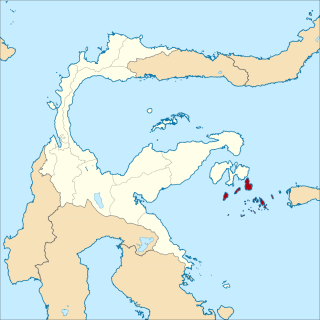
Central Sulawesi is a province of Indonesia located at the centre of the island of Sulawesi. The administrative capital and largest city is located in Palu. The 2010 census recorded a population of 2,635,009 for the province, and the 2020 Census recorded 2,985,734, of whom 1,534,706 were male and 1,451,028 were female. The official estimate as at mid 2022 was 3,066,143. Central Sulawesi has an area of 61,605.72 km2 (23,786 sq mi), the largest area among all provinces on Sulawesi Island, and has the second-largest population on Sulawesi Island after the province of South Sulawesi. It is bordered by the provinces of Gorontalo to the north, West Sulawesi, South Sulawesi and South East Sulawesi to the south, by Maluku to the east, and by the Makassar Strait to the west. The province is inhabited by many ethnic groups, such as the Kaili, Tolitoli, etc. The official language of the province is Indonesian, which is used for official purposes and inter-ethnic communication, while there are several indigenous language spoken by the Indigenous peoples of Central Sulawesi. Islam is the dominant religion in the province, followed by Christianity which is mostly adhered to by the people in the eastern part of the province.

Southeast Sulawesi is a province on the island of Sulawesi, forming the southeastern peninsula of that island, together with a number of substantial offshore islands such as Buton, Muna, Kabaena and Wawonii, together with many smaller islands. The capital is the city of Kendari, on the east coast of the peninsula.
Belitung is an island on the east coast of Sumatra, Indonesia in the Java Sea. It covers 4,800.6 km2 (1,853.5 sq mi), and had a population of 309,097 at the 2020 Census. Administratively, it forms two regencies within the province of Bangka-Belitung Islands. The island is known for its pepper and for its tin. It was in the possession of the United Kingdom from 1812 until Britain ceded control of the island to the Netherlands in the Anglo-Dutch Treaty of 1824. Its main town is Tanjung Pandan. The United Nations Educational, Scientific and Cultural Organization has declared 17 tourist attractions in the Belitung Geopark as world geoparks.

The Banggai Regency is a regency located at the eastern end of Central Sulawesi Province of Indonesia. It makes up a re-established regency (kabupaten), created on 4 October 1999 by splitting the existing Banggai Regency into this smaller Banggai Regency situated on the mainland of Sulawesi and a new Banggai Islands Regency comprising the offshore islands which are separated from mainland Sulawesi by the Peleng Straits. The residual Banggai Regency covers an area of 9,672.70 km2 and had a population of 323,626 at the 2010 census and 362,275 at the 2020 census; the official estimate as at mid 2022 was 370,970.

Peleng is an island off the east coast of Sulawesi, Indonesia and is the largest island of the Banggai Islands. It is surrounded by the Banda Sea and Molucca Sea and has an area of 2,406 km².
The Sula Islands Regency is one of the regencies in North Maluku province of Indonesia. It was originally formed on 25 February 2003, when it encompassed the three large islands comprising the Sula Archipelago, together with minor adjacent islands. However, the largest and most westerly of the three, Taliabu, was split off from the Sula Islands Regency on 14 December 2012 to form a separate regency.

Taliabu Island Regency is a regency in the North Maluku province of Indonesia, mainly consisting of the island of Taliabu, the most western geographically of the Sula Islands archipelago. It was formerly part of the Sula Islands Regency, but on 14 December 2012 it was administratively separated to form a separate regency. It is located to the west of Mangole Island and Sanana Island, the two islands which remain part of the Sula Islands Regency. Taliabu Island Regency covers 2,985.75 km2; it had a population of 47,309 at the 2010 Census and 58,047 at the 2020 Census; the official estimate as at mid 2022 was 63,231.

Jember Regency is a regency of East Java province, Indonesia. The population was 2,332,726 at the 2010 census and 2,536,729 at the 2020 Census. Its administrative capital is the urban area of Jember, which with 359,184 inhabitants in 2020 is the third largest urban area in East Java province but does not have municipality or city status as it is split between three separate districts. Jember is famous for its tobacco farms and traditional food called tape which is made of fermented cassava.

Pesisir Selatan Regency is a regency (kabupaten) of West Sumatra, Indonesia. It has an area of 6,049.33 km² and a population of 429,246 at the 2010 Census and 504,418 at the 2020 Census. The regency seat is at the town of Painan, in IV Jurai District.

The Banggai crow is a member of the crow family from Banggai regency in the province of Central Sulawesi in Indonesia. It is listed as critically endangered by IUCN. It was feared extinct, but was finally rediscovered during surveys on Peleng Island off the southeast coast of Sulawesi by Indonesian ornithologist Mochamad Indrawan in 2007 and 2008.

Dwarf cuscus (Strigocuscus) is a nocturnal, arboreal marsupial genus in the family Phalangeridae found only in Sulawesi and some of its surrounding small offshore islands. Due to the unique biogeography of Sulawesi giving sub-regions of endemism, it is likely that there are several different species or subspecies as yet to be described by science. So far, the genus contains the following species:
Bowokan Islands is the southern group of smaller islands within Banggai Islands chain of Banggai Regency of Central Sulawesi. The largest island is named Bowokan Island. Salue Timpaus Strait is to the east, and Gulf of Tolo to the West.

Kutai Kartanegara Regency is a regency of East Kalimantan province, Indonesia. It has a land area of 27,263.10 km2 and a water area of 4,097 km2, geographically located between 1°18′40″S and 116°31′36″E. The population of the regency was 626,286 at the 2010 Census and 729,382 at the 2020 Census; the official estimate as at mid 2021 was 733,626. The town of Tenggarong is the capital of the regency.

Sitaro Islands Regency is a regency located off the northern extremity of Sulawesi Island in the southern Sangihe Islands, North Sulawesi Province, Indonesia. The regency was formed under Law Number 15 Year 2007 from 2 January 2007, by separation from the Sangihe Islands Regency of which it had previously formed the southern part. The short form of the name is formed from the those of the three principal islands — Siau, Tagulandang and Biaro.

The Banggai Archipelago is a group of islands, which are located at the far eastern end of Central Sulawesi, Indonesia. It makes up a regency (kabupaten) of Central Sulawesi Province of Indonesia, created in 1999 by splitting the existing Banggai Regency into a new Banggai Regency situated on the mainland of Sulawesi and a Banggai Islands Regency then comprising the entire archipelago. In December 2014 a further splitting of the Regency was the removal of the more southerly seven districts to form a new Banggai Laut Regency.

Southeast Maluku Regency is a regency of Maluku, Indonesia. It is coincident with the Kei Islands, except that the city of Tual, although within the Kei Islands geographically and the seat of the Regency's administration, is since 17 July 2007 technically independent of the Regency. The land area of the Regency is 1,016.64 km2, while the sea area administered by the Regency was 3,181 km2; it had a population of 96,442 at the 2010 Census; this increased to 121,511 at the 2020 Census, and the official estimate as at mid 2022 was 124,199.
Banggai may refer to various locations in Indonesia:-

Banggai Laut Regency is a regency in the province of Central Sulawesi, Indonesia. The regency was established on 14 December 2012, partitioned from the Banggai Islands Regency. It comprises the main island of Banggai itself, the islands of Labobo and Bangkurung to the southwest of Banggai Island, and the numerous small Bokan Islands to the southeast. It covers a land area of 725.67 km2, and had a population of 70,435 at the 2020 Census; the official estimate as at mid 2022 was 71,350.

The Kingdom of Banggai was a petty kingdom in present-day Central Sulawesi, Indonesia. It was based around the Banggai Islands and the eastern coast of Sulawesi, centered at the island of Banggai. For a significant part of its history, the kingdom was under the overlordship of the Sultanate of Ternate.
On 4 May 2000 at 12:21 WITA, Banggai Islands Regency was hit by an earthquake of magnitude 7.5 , followed by a tsunami. The Banggai Islands, an archipelago located at the far eastern end of Central Sulawesi, Indonesia, was the worst affected by the earthquake. Eighty percent of Banggai's buildings were destroyed. Damage also occurred on Peleng. The earthquake triggered a local tsunami of up to 6 m in height that caused significant damage east of Luwuk on the mainland and on Peleng.















